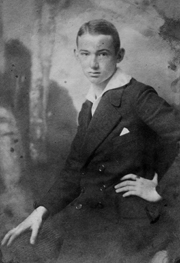1914–1918

1914
Max Peiffer took his university entrance examinations (Abitur) in Hattingen in 1914. At the urging of his parents, he went to Bonn that autumn to study medicine. He soon proved unsuited for the field, however, and switched to law. He attended the universities of Strasbourg, Frankfurt am Main, and Munich, receiving his doctorate in church law in Würzburg in 1918, and taking the state law clerkship examination. He was the youngest law clerk in Prussia.
He encountered works of contemporary art for the first time during his university years in Munich. The artist remarked at the time: “My favorite thing was to go to the little Goltz art dealership on Brienner Strasse, where I regularly saw the changing exhibitions. Such a visit had something of the forbidden, the adventurous about it.” (B. Bilzer, Peiffer Watenphul (Göttingen, 1974), p. 5). At Goltz, he saw works by Paul Klee for the first time, and resolved to visit him.
Lotte Pritzel arranged the meeting with Klee. When Max Peiffer sought him out at his apartment in Schwabing to ask him to teach him to paint, Klee declined, smiling that he was hardly a teacher, and referred him to the painter Stanislaus Stückgold. Peiffer did not like Stückgold’s teaching, however. He asked Klee again, and Klee promised to correct his works. In 1918, Peiffer was called up for military duty and sent to Mülheim an der Ruhr for training as an infantry lieutenant. The end of the war prevented his deployment to the front.
